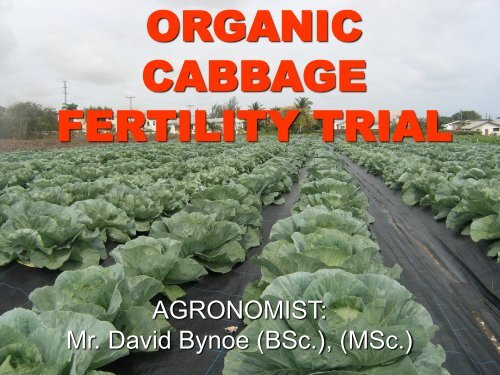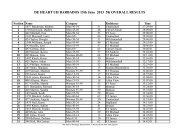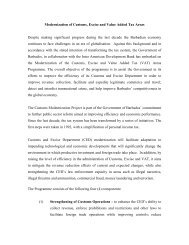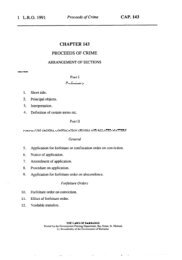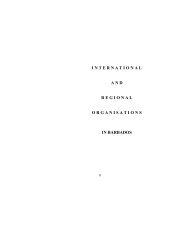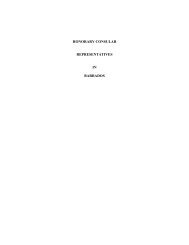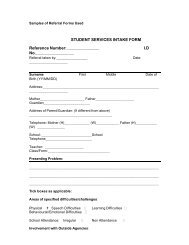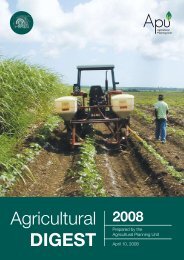organic manures with cabbage
organic manures with cabbage
organic manures with cabbage
Create successful ePaper yourself
Turn your PDF publications into a flip-book with our unique Google optimized e-Paper software.
ORGANIC<br />
CABBAGE<br />
FERTILITY TRIAL<br />
AGRONOMIST:<br />
Mr. David Bynoe (BSc.), (MSc.)
BACKGROUND<br />
Organic farming is a holistic management system<br />
which promotes and enhances:<br />
Agro-ecosystem health<br />
Biodiversity<br />
Soil biological cycles<br />
Soil biological activity<br />
Its management practices focus on creating as<br />
much as possible a close cycle .<br />
It provides economic, social, and environmental<br />
benefits.
BACKGROUND<br />
Fertility management remains one of the most<br />
crucial aspects of <strong>organic</strong> production systems<br />
and has been identified as a priority for<br />
research.<br />
Objectives<br />
• To determine the significance of various<br />
<strong>organic</strong> amendments for <strong>cabbage</strong> production<br />
as it relates to the provision of nitrogen,<br />
phosphorous, and potassium.<br />
• To generate scientific information alternative<br />
<strong>organic</strong> sources of nutrients in the Barbados.
METHODOLOGY<br />
Treatments & Experimental Design:<br />
The experiment was set up in a completely randomized design<br />
<strong>with</strong> two factors. The factors were soil amendment and quantity<br />
of soil amendment. The crop type selected was <strong>cabbage</strong>.<br />
Experimental Material:<br />
• Fertilizers: Sheep manure , Chicken manure, and Conventional<br />
Fertilizer<br />
• Crop: Cabbage<br />
• Fabric Mulch<br />
• Organic pest control methods<br />
• Land area: ¼ acre<br />
• Drip irrigation lines
METHODOLOGY<br />
• The soil was analyzed for soil C.E.C, pH,<br />
<strong>organic</strong> matter, soluble salts and soil<br />
nutrients.<br />
• Nutrient analysis of fertilizers:<br />
FERTILIZER N% P 2 O5% K 2 O%<br />
Sheep<br />
Manure<br />
Chicken<br />
Manure<br />
Conventional<br />
Fertilizer<br />
0.9 1.8 3.2<br />
1.1 3.7 3.2<br />
24 23 18
RESULTS & DISCUSSION
YIELD lbs/acre<br />
RESULTS & DISCUSSION<br />
CABBAGE YIELD PERFOMANCE<br />
35000<br />
30000<br />
25000<br />
20000<br />
15000<br />
10000<br />
5000<br />
0<br />
155 207<br />
FERTILZER QUANTITY<br />
CON<br />
CHIC<br />
SHE<br />
• The results showed clearly that chicken manure<br />
produces higher yields in <strong>cabbage</strong> than conventional<br />
fertilizer and sheep manure.
• The main effect of application rate is also<br />
insignificant.<br />
RESULTS & DISCUSSION<br />
Dependent<br />
YIELD<br />
Tests of Between-Subjects Effects<br />
Variable:<br />
Source Sig. Partial Eta Squared<br />
FERTQ<br />
FERTT<br />
FERTQ * FERTT<br />
0.411 0.057<br />
0.005 0.585<br />
0.239 0.212<br />
• For an application rate of 155 lbs/acre and 207<br />
lbs/acre the interaction between fertilizer and<br />
fertilizer quantity is insignificant.
RESULTS & DISCUSSION<br />
• Chicken manure produced significantly higher<br />
yields than conventional fertilizer (Sig 0.007 )<br />
and sheep manure (Sig 0.003).<br />
• On average 6638 lbs/acre more than<br />
conventional fertilizer and 7696 lbs/acre more<br />
than sheep manure.<br />
• There is no significant difference in the yield<br />
produced by conventional fertilizer and sheep<br />
manure.
SOIL ANALYSIS<br />
No drastic residual effect on pH, CEC, or<br />
<strong>organic</strong> matter content after a 3 month period.<br />
Soluble salts for all amendments were all<br />
above 750 ppm.<br />
Sheep manure treatment had the largest<br />
amount of residual phosphorus 65lb/acre<br />
followed by conventional fertilizer <strong>with</strong> 46<br />
lbs/acre and finally chicken manure <strong>with</strong><br />
39lbs/acre.
SOIL ANALYSIS<br />
• Sheep manure and conventional manure had<br />
the same amount of residual nitrogen left <strong>with</strong>in<br />
the soil 23lbs/acre. While chicken manure only<br />
had 21lbs/acre left in the soil.<br />
• As it relates to potassium a similar trend was<br />
followed.
WATER ANALYSIS<br />
pH 7.5<br />
Electrical Conductivity<br />
(µS/cm)<br />
7.9<br />
Calcium (mg/L) 71<br />
Magnesium (mg/L) 27<br />
Sulphate (mg/L) 43<br />
Chloride (mg/L) 232<br />
Sodium (mg/L) 80<br />
Nitrate (mg/L) 7.69<br />
Total Dissolved Solids 43
CONCLUSION &<br />
RECOMENDATIONS<br />
Chicken manure is a very feasible fertilizer<br />
substitute for conventional fertilizer and can be<br />
utilized by both <strong>organic</strong> farmers and<br />
conventional farmers.<br />
The major cost incurred <strong>with</strong> the use of chicken<br />
manure are transportation and application cost.
THANK YOU!<br />
THANK YOU!


